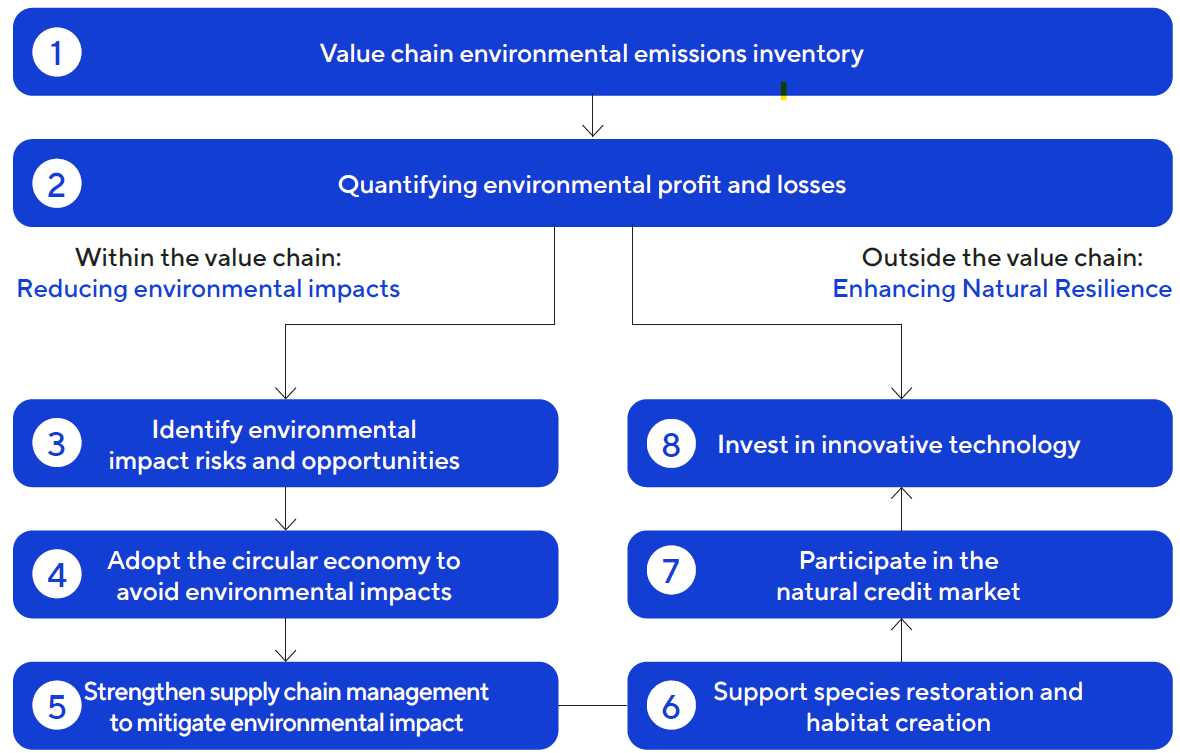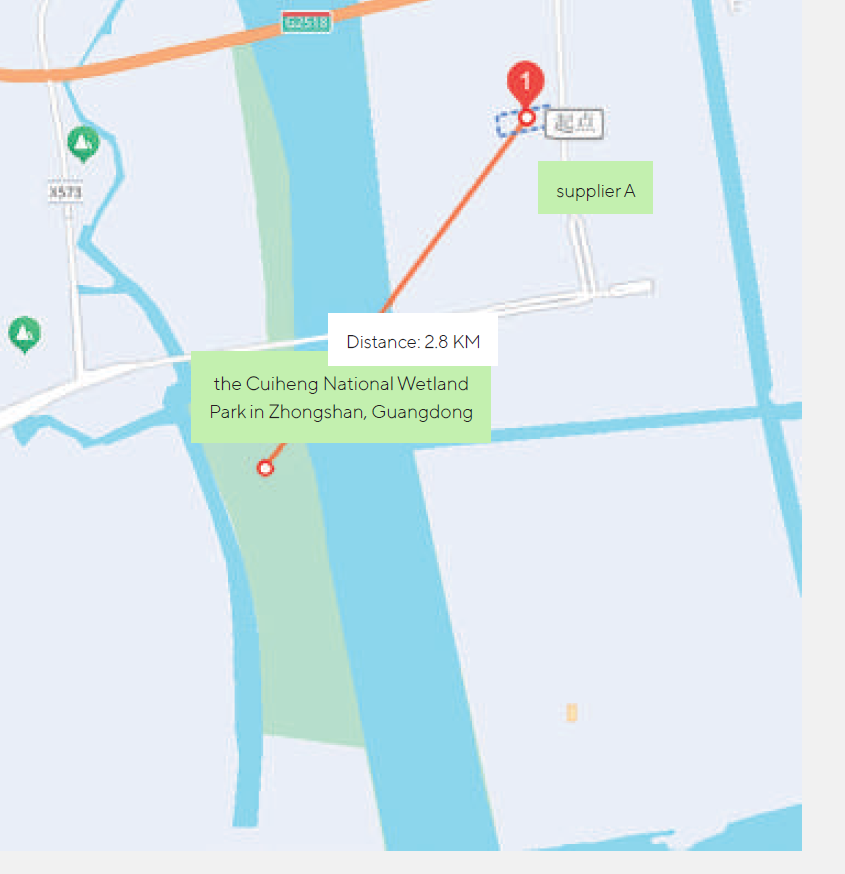Natural Capital
ASUS recognizes natural capital as the foundational resource for sustainable operations, encompassing land, freshwater resources, biodiversity, and ecosystem services. In alignment with global frameworks such as the United Nations Sustainable Development Goals (SDGs) and the Kunming-Montreal Global Biodiversity Framework (GBF), we have developed a natural capital strategy that balances risk mitigation with positive environmental impact. Anchored on two pillars—“Reducing Environmental Impacts” and “Enhancing Nature Resilience”—this strategy integrates actions across our value chain: internally, we identify and assess the environmental impacts of our operations and supply chain to drive targeted mitigation and sustainable management; externally, we explore innovative, nature-based solutions (NBS) in line with the Task Force on Nature-related Financial Disclosures (TNFD), and actively participate in habitat protection and biodiversity conservation to strengthen the long-term stability of ecosystem services.
Natural Capital Strategy Map

Environmental Profit and Loss (EP&L)
Since 2018, ASUS has implemented an Environmental Profit and Loss (EP&L) assessment using a lifecycle perspective to quantify the environmental impacts of raw material extraction, component manufacturing, product assembly, and operations. These impacts are monetized to improve comparability across different environmental issues and to inform decision-making. The EP&L results identify greenhouse gases, water resources, waste, and water pollution as priority focus areas1, with high-risk hotspots concentrated among component manufacturers (e.g., panels, motherboards, IC components such as CPUs, SSDs, HDDs, RAM, GPUs, and power supplies) and assembly facilities.
The 2024 EP&L results indicate a total environmental impact of USD 685 million, with greenhouse gas emissions and water pollution emerging as the primary hotspots. Within the supply chain, Tier 3 raw material extraction and Tier 2 component manufacturing contribute the most to this total impact.
Assessment and Management
Leveraging the Carbon Disclosure Project (CDP) greenhouse gas and water resource metrics, ASUS conducts assessments of 148 key suppliers and analyzes over 100,000 historical data points. These insights inform the development of action plans and management targets, with execution performance reviewed regularly to drive year-over-year improvements in all critical indicators. Historical management performance is summarized in the table below.
| Action Plans / Management Targets | 2024 Management Performance | |
|---|---|---|
| Management |
|
|
| Greenhouse Gases |
|
|
| Water Resources and Water Pollution |
|
|
| Hazardous Industrial Waste |
|
|
Supplier Environmental Management Performance Over the Years
For the greenhouse gas issues requiring prioritized management, ASUS has developed a three-phase action plan to systematically advance carbon reduction and risk control.
| 2022 | 2023 | 2024-2025 |
|---|---|---|
| Map the manufacturing processes for key components and identify emission hotspots—such as equipment with high energy consumption and processes with high carbon emissions. | Map carbon reduction paths for key components based on emission hotspots and suppliers’ capacity for reducing carbon emissions. | Collaborate with suppliers through assistance programs to advance technology-based carbon reduction by promoting the use of low-carbon materials, optimizing manufacturing processes, enhancing equipment energy efficiency, and integrating renewable energy sources. |
Biodiversity
Companies are shifting from traditional environmental pollution control toward biodiversity conservation, driven primarily by increasingly stringent international regulations on habitat protection. This trend has prompted governments worldwide to tighten environmental management2 of habitats, creating both new risks and opportunities for corporate operations, including stricter standards for water use, wastewater discharge, and land-use controls under species-habitat management policies3. Moreover, IPCC studies highlight that biodiversity conservation makes a significant contribution to net-zero carbon goals: by protecting habitats, natural carbon-sink functions are strengthened, carbon removal potential is increased, and the impacts of climate change on businesses are further mitigated.
For ASUS, biodiversity scarcity does not directly affect the inputs for component manufacturing or assembly, nor do ASUS or its suppliers’ operations currently lead to species disturbance or habitat fragmentation. However, as governments reinforce habitat-protection regulations, significant impacts on ASUS’s operations and its suppliers are anticipated. Accordingly, ASUS must proactively assess the potential effects of these policies on its operations and supply-chain management and develop corresponding response strategies4.
On the other hand, EP&L assessments reveal that water withdrawal and wastewater discharge represent ASUS’s second-largest environmental impacts, and suppliers’ water use and discharge directly affect local habitat quality and species survival. Therefore, ASUS has initiated biodiversity-risk identification and assessment for highly water-dependent supplier categories5 by leveraging the Key Biodiversity Areas (KBA) mapping tool to determine whether supplier sites are located in or adjacent to ecologically sensitive zones such as water-source protection areas and wetlands, and has strengthened audits of these high-risk suppliers.
Cast Study: Supply Chain Biodiversity Management
ASUS leveraged the Institute of Public and Environmental Affairs (IPE) in mainland China to identify that Supplier A’s facility is adjacent to the Cuiheng National Wetland Park in Zhongshan, Guangdong. This ecologically significant habitat spans 625.6 hectares, with wetlands comprising 63.21% of its area. It encompasses diverse ecosystems—from estuarine waters and mangroves to perennial rivers and marsh vegetation—and shelters several nationally protected Class-II wildlife species in China, including the Black Kite (Milvus migrans), the Blackwinged Kite (Elanus caeruleus), and the Eurasian Kestrel (Falco tinnunculus).
Supplier A is an IC packaging and storage equipment manufacturer whose critical processes include IC baking, solder-paste printing, component placement, reflow soldering, aging tests, and final assembly and packaging—high-density manufacturing operations. During ASUS’s annual on-site audits, we reviewed the supplier’s Environmental Impact Assessment report and annual pollution-emission monitoring data (covering domestic wastewater, process vents, and noise), confirming government approval and compliance with applicable regulations.

Given the facility’s proximity to an ecologically sensitive zone, ASUS has mandated the following actions:
- Establish a Biodiversity Management Framework: Integrate a biodiversity policy into the supplier’s internal management system, set concrete conservation objectives and action plans, and conduct regular performance reviews.
- Enhance Communication and Disclosure: Effectively communicate relevant policies and targets to internal staff and external stakeholders, and explore public disclosure channels for biodiversity commitments to bolster corporate transparency and accountability.
1. From a theoretical standpoint—and in line with the Science Based Targets Network (SBTN)—the hydrological cycle perspective treats water withdrawal (quantitative use) and discharge (qualitative impact) as interconnected phases of the same freshwater flow path. Within this cyclical system, pollutant discharges reduce the availability of downstream water bodies, diminishing the supply of usable freshwater within a watershed and thereby constraining a company’s future withdrawal potential. Consequently, from a risk-management viewpoint, integrating water quality and quantity under a unified “freshwater resources” management objective enables more accurate assessment of watershed water stress and pollution-induced resource depletion, and supports the setting of integrated targets that deliver both water-saving and pollution-reduction benefits.
2. Because most species primarily inhabit ecologically sensitive areas—such as watersheds, forests, and wetlands—the key to protecting biodiversity lies in preserving habitat integrity and quality. The Kunming–Montréal Global Biodiversity Framework, adopted in 2022, calls on governments worldwide to actively conserve biodiversity and establishes the “30×30” ambition: protecting at least 30 % of the planet’s terrestrial and marine areas and restoring 30 % of degraded ecosystems by 2030.
3. In 2024, China’s Ministry of Ecology and Environment released the China Biodiversity Conservation Strategy and Action Plan (2023–2030). Under Priority Action 13, “Environmental Quality Improvement,” it prescribes measures such as strengthening air-pollutant management, advancing industrial-park wastewater collection and treatment, intensifying plastic-pollution prevention, and dynamically publishing lists of priority new pollutants for control.
4. The electronics industry heavily depends on water for processes such as cleaning and cooling. When governments impose stricter water-withdrawal limits and wastewater-discharge standards to protect watershed ecosystems, companies must install effluent-treatment systems or improve water-recycling and reuse efficiency—measures that directly increase operational costs.
5. These high–water-dependency supplier categories include IC design firms, panel manufacturers, battery suppliers, and assembly plants.

